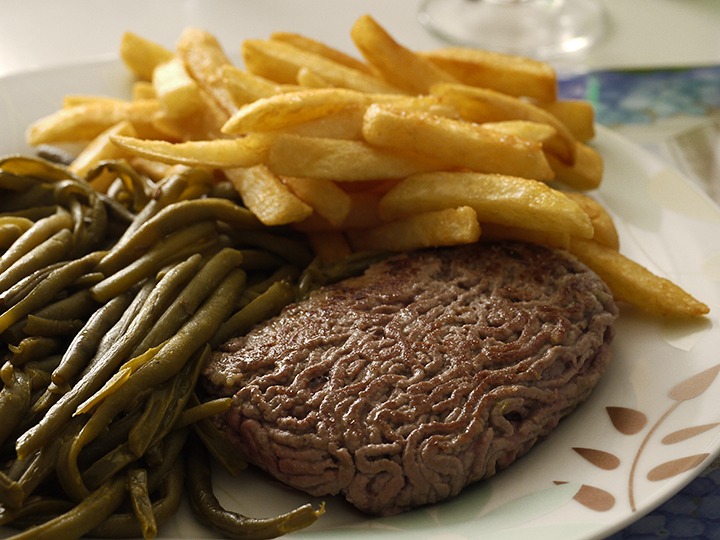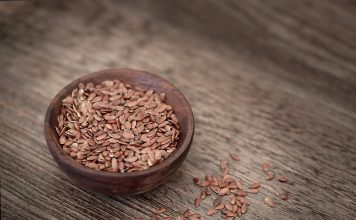| Issue #88 • July/August, 2004 |
Okay, it’s not everyday dining fare, I agree. But, tell someone you’re having horse steaks for supper, grilled to perfection and garnished with plenty of fresh herbs and vegetables, and you’re likely to get the same reaction as if you had casually mentioned you’re serving up your own leg.
But is setting the table with horse meat really that offensive an idea?
There is a ferocious ongoing debate in the U.S. over the right or wrong of hippophagy (or making a meal out of Ol’ Lightnin’). But the reality is that people have been eating horse meat for as long as people and horses have shared the same lands, and most countries around the globe would no more consider banning horse meat for human consumption than they’d outlaw onions.
The issue is complicated, divisive and highly emotionally charged, and will probably never be completely resolved; but the fact remains that eating horse meat is no less natural for humans than consuming any other large-built domesticated livestock, no matter the taboo status some overzealous animal lovers continue to project onto it.
Though virtually all the “animal rights” lobbies are constantly working toward a complete ban on using horses for anything more demanding than countryside scenery filler, those practical-minded, self-reliant people who understand the often hard realities of food production at the grassroots level know that horses, for all their intrinsic beauty and millennia of loyal service, are, in effect, not much more than horn-less cows—especially in emergency survival situations. And why not? Horse meat is perfectly good, healthy, organic protein.

The ancient Romans knew it, the American Indians knew it, the original homesteaders knew it, and the animal rights crowd knows it too—even if they don’t like admitting to the knowledge. (Apparently, one of the few historically significant groups who didn’t know it was the Donner Party, and look at how they ended up.)
B-But it’s a horse!
Before we go on, the purpose of this piece is to offer information and ideas on a legitimate, high-protein food alternative, not to in any way promote horse meat as a staple food item for the American table. That horse meat could come in handy in times of serious and unplanned need is almost secondary to the fact that there’s absolutely nothing wrong with eating it as often as desired in non-survival situations, too.
Many, if not most, self-reliant homesteads include horses among their livestock inventory, and those who don’t have horses often wish they did. In addition to their roles as draft and work stock, horses are usually beloved pets as well.
As with every other aspect of life, it’s up to the individual to decide the ultimate status and fate of the horses he or she owns (and pays taxes on).
Sounds . . . all right.
With a delicate flavor similar to beef, though many describe its taste as slightly sweeter than other meats, horse meat can be used to replace beef, pork, mutton, and any other meat in virtually any recipe, though most aficionados prefer it in marinated or spicy dishes. Nutritionally, horse meat has around 40 percent fewer calories than the leanest beef, while supplying 50 percent more protein and as much as 30 percent more iron; and horse fat is considered an excellent health-conscious deep-frying alternative, especially for delicately-flavored foods that are easily overpowered by heavier oils.
Young animals produce naturally tender, light-colored meat—almost like veal—with the meat becoming redder (from its high iron content) the older the horse gets. The meat from older horses can be tough, though, depending on how it’s processed, stored, and used, but not nearly as tough as beef. Horse meat is generally lean and tender, usually gently-marbled, and cooks done much faster than either beef or pork.
Most American adults have probably eaten horse meat, though they
didn’t know it at the time. Ground beef imported from South America for the steadily expanding fast food industry was once notorious for its horse meat content. Remember when the big hamburger chains began stressing their use of “100 percent pure beef” in commercials and ads? It wasn’t that long ago. Strict laws, and even stricter inspection procedures, stopped much of the blatant offenses, but horse meat still continues to filter onto the American food market, mostly in highly spiced canned import delicacies.
Still, a few restaurants in states where horse meat is not specifically banned do quietly offer special-order horse meat dishes, especially for visiting foreigners; which only makes good business sense.
To diners in Canada, Germany, Mexico, Belgium, Italy, so on around the world, horse meat is not a rare and expensive delicacy nibbled at by only a few societal oddballs with bizarre tastes, as has often been claimed by its detractors. It’s practically everyday fare for significant portions of the population. As much as a third of the French eat horse meat regularly, according to some industry estimates, even though a suspicious trichinosis scare in the 1970s curtailed consumption nationally. Sure, not everyone who eats food in those countries has tasted horse meat, but enough do eat it, and eat it often enough, to keep the production of horse meat in commercial quantities firmly established in agriculture’s “big business” category. In fact, so many Japanese restaurants offer horse meat, sliced thin and either grilled lightly or served completely raw, that a large sub-segment of that nation’s dining industry depends on its continued importation.
So we’ll eat Bambi, but we won’t eat Trigger?
The point here is that: even though the overwhelming attitude in the United States is that Misty of Chincoteague or Black Beauty should not be used as food on its “cringe factor” alone, millions of other people in other places have absolutely no moral problems with horse meat. In fact, the various cultures worldwide that oppose the eating of beef and pork far outnumber those with objections to human consumption of horse meat.
And that’s a shame in a world as hungry as this one.
Personally, if circumstances I had no control over forced a choice between feeding my family a deer—whose health condition and possible parasites I knew nothing about—and a horse I knew to be strong and disease-free, I wouldn’t hesitate to choose the horse meat. I’ve had horse meat as barbecued roast, in chili, and as hot Italian-style sausage, and enjoyed them all. I’ve also eaten bear and moose in Montana, ‘possum in South Carolina, alligator in Louisiana, javalina in Arizona, rattlesnake in New Mexico, pronghorn antelope in Colorado, and similar regional favorites around the country, and I’m firmly convinced that properly dressed horse meat tastes far better than any gamy old wild animals, no matter how well they’re prepared.
What are the drawbacks?
On the down side—again, depending on its processing—horse meat tends to be more fibrous than beef, and is subject to much quicker spoiling. Horse meat can be safely kept in the refrigerator for no more than a couple of days (about the same time as hamburger) and up to four months in the freezer (as opposed to about six months for hamburger); though thorough vacuum-packing before freezing does extend storage life. The fat, especially when used for deep-frying, doesn’t keep for very long, either; in busy European restaurant kitchens it’s usually changed every other hour or so.
Horses don’t share any parasites with humans (like cattle, hogs, sheep, deer, goats, so on, definitely do), but they are subject to several rare equine-only diseases whose side effect symptoms can sometimes pass on through the meat. However, since horses are often classified as “dead end hosts,” which means that many of the ailments they get from other animals don’t pass on to humans or anything else, strict American veterinary practices usually catch any truly nasty conditions before they become serious health issues to either other horses or people. In fact, many veterinarians consider horse medications a worse health concern for humans than horse diseases.
Like with many other life-crucial situations, though, self-education is essential here.
Surely it can’t be legal
Depending on the state, fresh horse meat can be hard to come by for those who don’t already have their own horses and either their own processing (slaughterhouse) facilities or a local meat processing plant nearby. All states have animal cruelty laws with stiff penalties, and several (including my adopted home state of Texas) have laws specifically forbidding the buying and selling of horse meat for human consumption (though it is available in most Asian grocery stores; packaged in chunks no larger than five pounds and prominently labeled “not for human consumption” when it is, in fact, perfectly safe for people to eat in any way they choose—even raw).
Don’t forget: the overwhelming objection to eating horse meat comes strictly from its perceived taboo factor, and not from any fact-based health concerns.
So far, the only state that has absolutely outlawed the use of horse meat on the family table is (surprise!) California, though Californians have no problem feeding it to their high-dollar dogs and cats. But even in the handful of states where horse meat is regulated, including California, giving and receiving horse meat as a gift is perfectly legal, and bartering for it will probably always remain a legal gray area.
Let’s eat!
Unless some cataclysmic event drastically changes the world as we know it—these are, after all, unusually dangerous times—horse meat will never even come very close to truly replacing beef, pork, poultry, fish, venison, and the other “mainstream” meats in the appetites of American diners. But if circumstances end up demanding the use of horse meat, it’s good to know in advance that horses are far more valuable to survival than mere scenery filler.
And it is, after all, better than serving up your own leg.
But remember: it’s a good idea, if you’re thinking of barbecuing up a horse quarter, or even a Quarter Horse, to make sure everyone knows exactly what kind of meat you’ve got roasting on the cooker well before the blessing is said. Even the best of friends can come to blows where food ambushes are concerned.
Again, horse meat can be used to replace beef in almost any familiar American dish, but here are a few recipes from serious European horse meat eaters. If you don’t care to use horse meat in these recipes, any other red meat can be substituted.
Recipes
Picula ad Caval
This traditional Italian recipe will serve 6
2¼ pounds ground horse meat
1 Tbsp. olive oil
2-½ ounces ground cured lard (or pancetta)
2 onions, minced
1 glass dry white wine (though some Italian chefs prefer broth)
6 ripe tomatoes, blanched, peeled, seeded, chopped, and drained
2 bell peppers, ribbed and seeded, then diced
2 Tbsp. minced fresh herbs (basil, sage, and rosemary in proportions to taste)
1 clove garlic, minced
salt and freshly ground pepper
Heat the oil, lard, and onion in a skillet. Sauté until the onion has become golden but don’t let it get really brown. Add the horse meat and brown it, stirring frequently. When it has browned, sprinkle in the glass of wine and reduce the heat to a bare simmer. Cover it, and let it cook for at least an hour. Mix in the chopped tomatoes and diced peppers, and continue cooking for another half hour.
Ten minutes before removing the dish from the stove, sprinkle the minced herbs over everything. Serve it hot with salt and pepper to taste.
Pastissada
Another traditional Italian recipe from the Verona area.
2 pounds horse meat
2 ounces lard or porkback fat
2-3 carrots, cut into slivers
2 sticks celery, diced
1 large onion, diced
4 cloves
a dozen coriander seeds
1 bay leaf
1 clove garlic
1 bottle Italian red wine
flour, enough to brown the meat with
¼ cup olive oil
salt & pepper to taste
1 Tbsp. butter kneaded into enough flour to make a small ball
paprika to taste
Slather the meat with the lard and slivers of carrots. Dice the other vegetables and put them, with the meat and spices (except the paprika) in a bowl. Pour the wine over everything, then cover and marinate in the refrigerator for three days, turning the meat occasionally.
Pat the meat dry with paper towel (keep the vegetables and the marinade), flour it, and brown it in the oil over a brisk flame. Add the vegetables. When they’ve cooked for a few minutes, pour the marinade over the meat. Reduce the heat to a simmer and cook for about three hours. Once the meat is done, remove it to a platter saving the sauce that has been formed with the marinade.
Return the sauce to the fire, thicken it with the butter-flour ball, and season it to taste with paprika. Pour the sauce over the meat, and serve with a good traditional side dish.
Filet Mignon
This simple French classic serves 4.
4 four-ounce filets of horse
4 slices bacon
salt and pepper to taste
Prepare exactly as for a filet mignon. Wrap outside of filet with uncooked bacon slice and secure with toothpicks. Broil to taste.
Sauerbraten (Sour Roast)
Practically a German sacrament
2-½ lbs. horse meat roast
4 strips bacon (optional)
soup vegetables: carrot, celery, leek (optional), parsley root (optional), onion (optional)
1 cup red wine vinegar
1 pint red wine (optional)
1 garlic clove
2 bay leaves
1 Tbsp. juniper berries
3 allspice corns and/or cloves
3 peppercorns
1 thyme branch
¼ cup pork lard
1 Tbsp. flour (optional)
½ cup raisins
salt
pepper
maple syrup (to taste)
Vigorously rub the roast with the bacon. Clean and wash the vegetables and cut them into pieces. Bring the vinegar to boil with some water or stock, then let it cool down a bit and add the meat, garlic, spices, and the vegetables. Let it marinade in a closed bowl for several days (but at least 24 hours) in a cool place.
Remove the horse meat from the marinade and roast it in the lard. Then slowly add the marinade, together with the vegetables and the spices. Braise it in the oven for 2 to 2½ hours at 350 degrees. Remove the bay leaves, the cloves and the juniper berries from the gravy. Strain the gravy, and perhaps thicken it with some flour. Add the raisins and season it with salt, pepper, and maple syrup. Serves 4.














